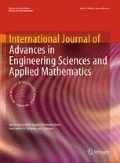The continuum theory of mixtures allows for a systematic study of mixture by taking into account the individual responses of its constituents and their interactions. The aim of this special issue is to bring together researchers working in mixture theory with different thematic foci (experiments, development of mathematical models, numerical simulations in real world applications) and communicate the ideas between the experimentalists, engineers, physicists interested in the development of mathematical models and mathematicians oriented on numerical methods.
The editorial presents a brief remark on different aspects of mixture theory. This paper highlights the breadth of recent applications of mixture theory. A brief note on the boundary conditions and their related issues is made. Further, the need and scope for experimental design and measurement techniques for validation of mixture models is presented. Finally, the authors comment on mathematical issues concerning numerical simulations of mixture models.
In continuum mechanics, expressing governing equations using bracket formalism has significantly expanded. In mixtures models that use bracket formalism, the reversible part of the evolution equation is constructed by a Poisson bracket and a Hamiltonian function representing energy. In the second paper presented in this issue, the construction of Poisson brackets coupling with electrodynamics has been exemplified. In this, the geometric means of construction of Poisson brackets and its projection has been discussed in detail. Further, a geometrical way of coupling two canonical Poisson brackets has been illustrated with known physics of coupling between electromagnetic field and transport of matter.
Industrial usage of various multicomponent systems usually calls for numerical simulations of such systems. Due to the complex nature of such systems there exist numerical challenges in its simulation. In the third paper, a multicomponent system is simulated. It is seen that using realistic parameter values cause numerical difficulties, for example, variations in different physical properties of various components of the system complicates the implementation. This study presents a straightforward implementation of ternary Cahn–Hilliard–Navier–Stokes type model to simulate the behavior of a three- component system (glass/tin/nitrogen), using parallel direct sparse solvers in FEniCS Project.
Another work on multicomponent system involving Plasma and RBC’s is presented in the fourth paper. In this paper, a mixture theory approach has been used to model the blood, wherein the Plasma is treated as the viscous fluid and the RBC’s are modeled as a nonlinear fluid with shear dependent viscosity. The study also emphasizes on the ability of the model to account for the hematocrit effect and drag and lift forces between the Plasma and the RBC’s. Validation of the mixture model with experimental data is also presented in the paper.
Shape memory polymers find its wide usage especially in biomedical and aerospace industries. Development of generic models that capture various phenomena exhibited by these polymers would facilitate its usage further. In the final paper, a subclass of shape memory polymers (SMP), known as the crystallizable SMP, is considered for study, wherein an existing model is enhanced to include temperature-dependent viscoelastic property. The polymer network, after the onset of the crystallization or the semi-crystalline form, is modeled using the mixture theory and the theory of multiple natural configurations. The model is tested for uniaxial tensile boundary value problem.
We thank all the authors who have contributed to this special issue on mixture theory. We extend our thanks to the Journal Editors for giving us the opportunity to put together this special issue on a significant area which connects engineering science and applied mathematics. We believe you would find this issue as exciting and enriching as we found in bringing this special issue to fruition.
Order of papers:
-
1.
Remarks on continuum theory of mixtures: Editorial to special issue on mixture theory.
-
2.
Hamiltonian coupling of electromagnetic field and matter.
-
3.
Modeling the mechanical behavior of crystallizable shape memory polymers: incorporating temperature-dependent viscoelasticity.
-
4.
On some practical issues concerning the implementation of Cahn–Hilliard–Navier–Stokes type models.
-
5.
Flow of blood in micro-channels: recent results based on mixture theory.
Author information
Authors and Affiliations
Corresponding author
Rights and permissions
About this article
Cite this article
Kannan, K., Průša, V. & Wineman, A. Special issue on mixture theory. Int J Adv Eng Sci Appl Math 9, 1–2 (2017). https://doi.org/10.1007/s12572-017-0183-8
Published:
Issue Date:
DOI: https://doi.org/10.1007/s12572-017-0183-8

